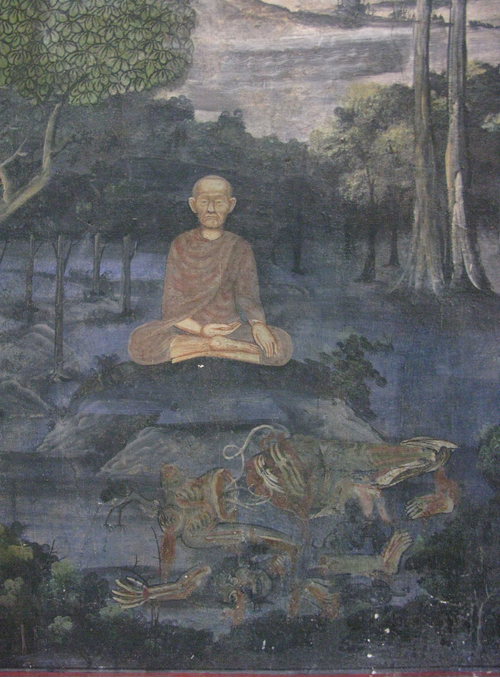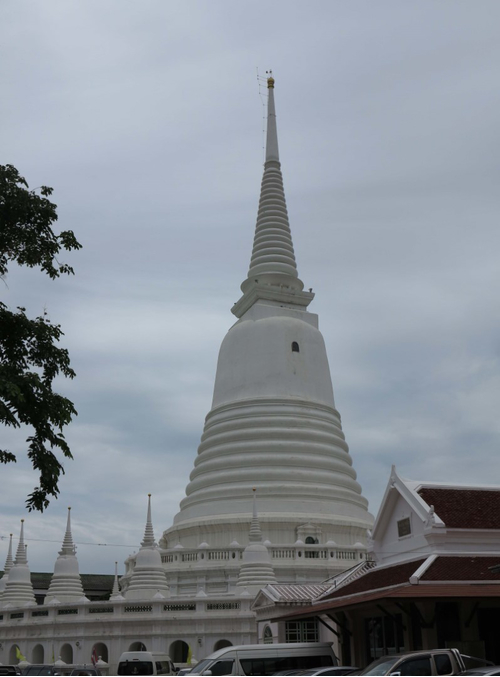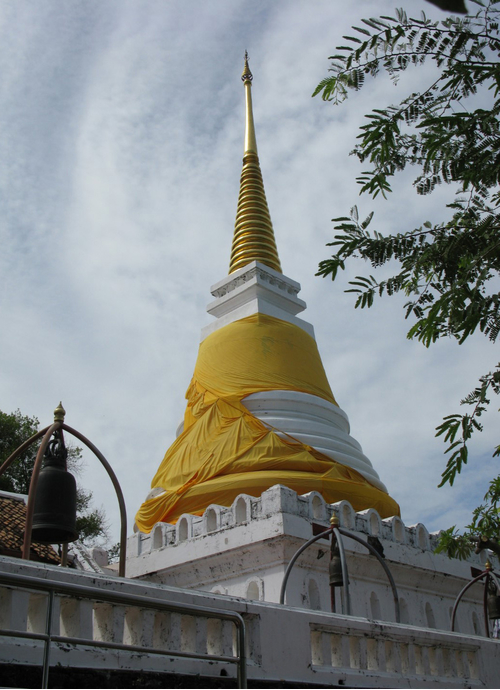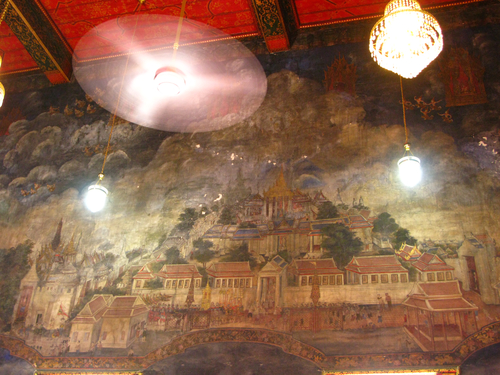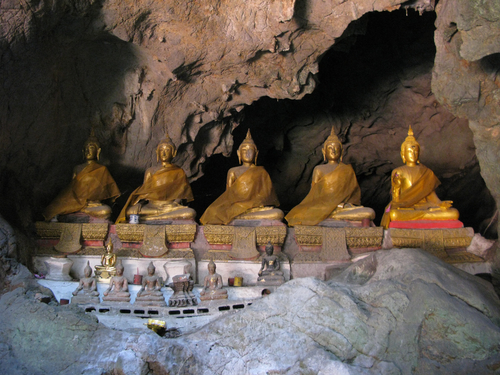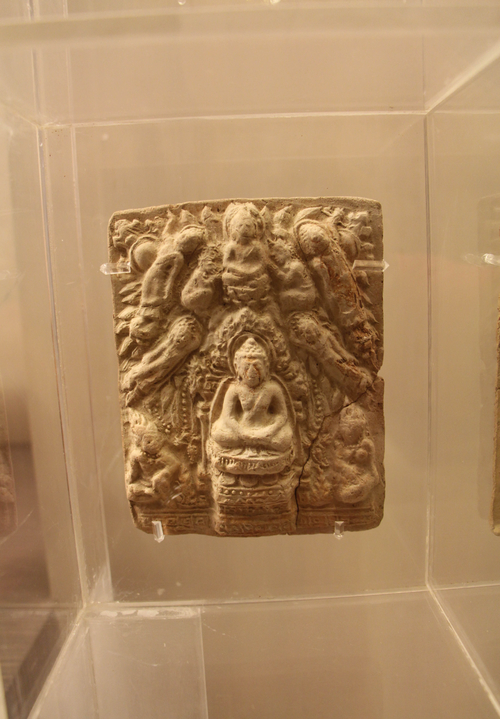ค้นหางานศิลปกรรม
ฐานข้อมูลศิลปกรรมในเอเชียตะวันออกเฉียงใต้
จิตรกรรมจิตรกรรมเรื่องอสุภกรรมฐาน
จิตรกรรมเรื่องอสุภกรรมฐานภายในพระอุโบสถวัดโสมนัสวิหารฯ เป็นภาพภิกษุพิจารณาซากศพประเภทต่างๆจำนวน 10 ประเภท โดยแต่ละประเภทเหมาะสมกับผู้มีจริตนิสัยแตกต่างกันไป แต่ละห้องภาพมีองค์ประกอบที่คล้ายคลึงกันคือมีภาพพระสงฆ์ 1 รูป พิจารณาซากศพ 1 ประเภท โดยอยู่ในตอนล่างของภาพซึ่งแสดงถึงระยะที่อยู่ใกล้ผู้ชม เบื้องหลังในตำแหน่งที่สูงขึ้นแสดงระยะที่อยู่ไกลออกไปเป็นภาพทิวทัศน์ ประกอบด้วยทิวเขา ป่าไม้ มีเส้นขอบฟ้าเพื่อกำหนดระยะของวัตถุอื่นๆ ในภาพที่อยู่ไกลออกไปและแสดงบรรยากาศของเวลาที่น่าจะเป็นยามเย็นหรือใกล้ค่ำ ภาพอสุภกรรมฐานทั้ง 10 ประเภท ได้แก่1.อุทธุมาตกอสุภ (ศพขึ้นอืด)2. วินีลกอสุภ (ศพสีคล้ำ) 3.วิปุพพกอสุภ (ศพที่มีน้ำเหลือง) 4.วิจฉิททกอสุภ (ศพที่ถูกตัดเป็นท่อน) 5.วิกขายิตกอสุภ (ศพที่มีสัตว์ทั้งหลายกัดกินโดยอาการต่างๆ)6.วิกขิตตกอสุภ (ศพกระจุยกระจาย) 7.หตวิกขิตตกอสุภ (ศพถูกฟัน)8.โลหิตกอสุภ (ศพที่มีเลือดไหล) 9.ปุฬุวกอสุภ (ศพมีหนอน) 10.อัฏฐิกอสุภ (ศพที่เป็นร่างกระดูก)
สถาปัตยกรรมพระบรมธาตุมหาเจดีย์
เจดีย์ทรงระฆังในผังกลมขนาดใหญ่ ส่วนฐานประกอบด้วยช่องประตูวงโค้งสลับคั่นด้วยเสาหลอกอย่างตะวันตก บานประตูประดับเหล็กดัด มีบันไดทางขึ้นสู่ฐานประทักษิณด้านบน ซึ่งมีช่องประตูที่สามารถเข้าสู่บริเวณภายในองค์เจดีย์ได้ 4 ทิศ รูปแบบภายนอกของเจดีย์ประกอบด้วยส่วนรองรับองค์ระฆังที่เป็นชุดมาลัยเถาซึ่งเป็นที่นิยมในสมัยอยุธยา แต่ได้เพิ่มมาลัยเถาให้เป็น 7 ชั้น ส่งผลให้องค์ระฆังมีขนาดเล็กลงกว่าเจดีย์ทรงระฆังในสมัยอยุธยา ถัดขึ้นไปเป็นบัลลังก์สี่เหลี่ยม ก้านฉัตรหรือแกนปล้องไฉนที่มีเสาหารล้อมรอบ ปล้องไฉน ปลียอดและลูกแก้ว รอบพระเจดีย์มีระเบียงคดในผังกลม หลังคาตัดเรียบแบบดาดฟ้า ประดิษฐานเจดีย์รายซึ่งเป็นเจดีย์ทรงระฆังจำนวน 18 องค์ ล้อมรอบเจดีย์ประธาน
สถาปัตยกรรมพระเจดีย์หลวง
รูปแบบเป็นเจดีย์ทรงระฆังตามแบบพระราชนิยมในรัชกาลที่ 4 กล่าวคือ เป็นเจดีย์ทรงระฆังในผังกลม ตั้งอยู่บนฐานประทักษิณในผังสี่เหลี่ยม ส่วนฐานประทักษิณเจาะช่องวงโค้ง ที่พนักระเบียงประดับด้วยช่องวงโค้งเช่นกัน มีบันไดทางขึ้นทางด้านตะวันออกและตะวันตก ลักษณะเป็นบันไดประชิด องค์เจดีย์ประกอบด้วยส่วนฐานบัวคว่ำ-บัวหงาย ชุดมาลัยเถาและบัวลูกแก้วอกไก่รองรับองค์ระฆัง มีบัลลังก์สี่เหลี่ยม ปล้องไฉนและปลียอด ปัจจุบันได้รับการปฏิสังขรณ์ให้มีสภาพสมบูรณ์
จิตรกรรม จิตรกรรมเรื่องสังคายนาพระไตรปิฎก
จิตรกรรมฝาผนังเขียนเล่าเหตุการณ์การสังคายนาพระไตรปิฎกในพุทธศาสนารวมทั้งสิ้น 9 ครั้ง เริ่มจากผนังด้านขวาของพระประธาน ซึ่งเป็นเหตุการณ์ในอินเดีย เรียงลำดับไปยังผนังด้านหลังซึ่งเป็นเหตุการณ์ในลังกา และผนังด้านซ้ายซึ่งเป็นเหตุการณ์ในล้านนาและในสมัยรัชกาลที่ 1 ผนังเบื้องหน้าพระประธานเขียนภาพตู้พระไตรปิฎก 3 ตู้ ซึ่งน่าจะหมายถึงพระไตรปิฎกที่ได้รับการสังคายนาแล้ว ได้แก่ พระวินัยปิฎก พระสุตตันตปิฎก และพระอภิธรรมปิฎก ภายในตู้บรรจุพระคัมภีร์ห่อด้วยผ้ายกปิดทอง มีภาพผู้คนหลากหลายเชื้อชาติ สังเกตได้จากการแต่งกายที่แตกต่างกันกำลังกราบไหว้บูชาตู้พระธรรมเหล่านั้น
ประติมากรรมพระพุทธรูปทรงพระราชอุทิศของรัชกาลที่ 4 และพระราชโอรส
พระพุทธรูปปูนปั้นปิดทอง ซึ่งน่าจะเป็นการปฏิสังขรณ์ตามเค้าโครงของพระพุทธรูปเดิมที่อาจเป็นฝีมือช่างในท้องถิ่น พระวรกายอวบอ้วนขนาดใหญ่ พระพักตร์กลม พระเนตรเหลือบต่ำ แนวพระขนงโก่งต่อเนื่องกับพระนาสิกแหลม พระหนุและพระศอสั้น มีพระรัศมีเปลวค่อนข้างสั้น มีอุษณีษะ เม็ดพระศกเล็กคล้ายหนามขนุน พระกรรณยาวใหญ่ พระพุทธรูปแสดงปางมารวิชัยปลายนิ้วพระหัตถ์ทั้งสี่ยาวเสมอกัน ครองจีวรห่มเฉียง สังฆาฏิเป็นแถบใหญ่ยาวจรดพระนาภีปลายตัดตรง ประทับนั่งบนแท่นฐานปูน เบื้องหลังมีเสาที่ตกแต่งบัวหัวเสาด้วยลายใบผักกาดแบบตะวันตก รองรับซุ้มปูนปั้นปิดทองทำเป็นรูปลำตัวนาคหยักโค้ง ปลายซุ้มเป็นรูปนาคหันหัวเข้า ยอดกลางซุ้มเป็นลวดลายเทพนม มีช่อลายกระหนกประดับ ที่ผนังถ้ำด้านซ้ายของพระพุทธรูปปางมารวิชัยองค์ใหญ่มีจารึกประกาศพระบรมราชโองการ (สะกดตามรูปและอักขรวิธีเดิม) ว่า “พระพุทธปฏิมารูปพระองค์นี้ เปนของท่านผู้มีศรัทธาโบราณสร้างไว้มีอยู่ในที่นี้นานแล้ว กับด้วยพระพุทธปฏิมารูปอื่นอีกสองพระองค์เคียงกัน ซึ่งตั้งต่างเบื้องขวาพระองค์นี้นั้น ครั้งเมื่อ ณ วัน ๗ ขึ้น ๕ ค่ำ เดือน ๒ ปีมเมีย สัมฤทธิศก ศักราช ๑๒๒๐ พระบาทสมเด็จพระจอมเกล้าเจ้าอยู่หัวเป็นพระเจ้าแผ่นดินสยามพระองค์ที่ ๔ ในพระบรมราชวงษ์อันนี้ ได้เสด็จพระราชดำเนินมาประภาศเมืองเพชรบุรี ได้เสด็จประภาศถึงถ้ำนี้ ทอดพระเนตรเห็นพระพุทธรูปสามพระองค์นี้ ตั้งอยู่นอกกำแพงกั้นถ้ำไว้ชอบกลอยู่ จึงได้มีพระบรมราชโองการดำรัสสั่ง ให้พระยาหัตถการบันชา จางวางช่างสิบหมู่ จ้างช่างปั้นปฏิสังขรณ์พระพุทธปฏิมารูปพระองค์นี้ขึ้นแล้ว ให้ลงรักถวาย ทรงปิดทองเป็นส่วนหลวง แต่พระพุทธรูปสองพระองค์ตั้งอยู่เคียงกัน ฝ่ายขวาพระพุทธรูปพระองค์นี้นั้นได้พระราชทานให้พระเจ้าลูกยาเธอพระองค์ใหญ่สองพระองค์ คือพระองค์เจ้านภวงษเปนกรมหมื่นมเหศวรศิววิลาศ ได้ว่ากรมล้อมพระราชวังพระองค์หนึ่ง พระองค์เจ้าสุประดิฐเป็นกรมหมื่นวิษณุนาถนิภาธร ได้ว่ากรมพระคลังมหาสมบัติพระองค์หนึ่ง ปฏิสังขรณ์พระองค์ละพระองค์ เพื่อจะให้เปนพระเกียรติยศสืบไปภายน่า การปฏิสังขรณ์พระพุทธปฏิมารูป ๓ พระองค์นี้เปนอันสัมฤทธิบริบูรณแล้ว ทรงพระราชอุทิศส่วนพระราชกุศลแลอวยไชยอวยพรไว้แก่เทพยดา มนุศทั้งปวง บันดาที่ได้มายังถ้ำนี้ แลได้เห็นได้นมัสการพระปฏิมารูปทั้ง ๓ พระองค์นี้จงทุกคน แลทรงพระอธิฐานด้วยการพระราชกุศลนี้ว่า ในประจุบันภพนี้ขอให้พระองค์และพระเจ้าลูกยาเธอทั้งสองพระองค์ มีพระชนมายุยืนยาวถาวรปราศจากโรคาทิอุปัทวันตรายทั้งปวง เปนศุขสวัศดีไปสิ้นกาลนาน เพื่อจะได้สมัยกาลโอกาสเปนที่ทรงบำเพญพระราชกุศลต่างๆ เปนอันมาก ในเพลาเมื่อได้มาประสบพบบุญอรุโณภาศ คือ พระพุทธสาศนาแลพระราชศรัทธาแลศิริราชสมบัติ แลขอให้พระราชกุศลนี้จงเปนปัจจัยให้ได้เสดจถึงที่สิ้นสุด ดับแห่งสังสารวัฏทุกขทั้งปวง คือ พระอมฤตยนฤพานนั้นเทอญ มีพระบรมราชโองการให้จารึกคำนี้ไว้ วัน ๕ ขึ้น ๑๐ ค่ำ เดือน ๘ ปีวอกโทศก เปนปีที่ ๑๐ ในรัชกาลประจุบันนี้”
ประติมากรรมพระพุทธรูปประจำแผ่นดิน
พระพุทธรูปประทับนั่งเรียงกัน จำนวน 5 องค์ เป็นพระพุทธรูปในศิลปะรัตนโกสินทร์ในช่วงรัชกาลที่ 3-4 กล่าวคือ พระพักตร์สงบนิ่งคล้ายหุ่น มีอุษณีษะ และพระรัศมีเป็นเปลวสูง เม็ดพระศกเล็ก พระขนงโก่ง พระเนตรเหลือบต่ำเรียวเล็ก พระนาสิกโด่ง แย้มพระโอษฐ์ ปลายตวัดขึ้นเล็กน้อย พระกรรณยาว ครองจีวรห่มเฉียง ประทับนั่งบนฐานสิงห์ประดับกลีบบัว ที่ผ้าทิพย์ของพระพุทธรูปเหล่านี้ประดับตราพระบรมราชสัญลักษณ์ประจำพระองค์ในรัชกาลที่ 1-4 และมีข้อความจารึกบนแผ่นหินที่ฐาน โดยมีรายละเอียดที่แตกต่างกัน ดังนี้1.พระพุทธรูปปางมารวิชัยขัดสมาธิเพชร มีจารึกที่ฐานว่า “พระพุทธรูปเสดจ์นั่งขัดสมาธิเพชรพระหัถขวาห้อยพระเพลาพระองค์นี้ ตามอย่างพระประจำแผ่นดินพระบาทสมเดจ์พระพุทธยอดฟ้าจุฬาโลกย์ ซึ่งเปนพระเจ้าแผ่นดินสยามพระองค์ที่๑ ในพระบรมราชวงษซึ่งดำรง ณ กรุงเทพมหานครอมรรัตนโกสินทรมหินทรายุทธยาบรมราชธานี ณ ตำบลบางกอก” ที่ผ้าทิพย์ประดับตราอุณาโลม2.พระพุทธรูปปางมารวิชัยขัดสมาธิราบ มีจารึกที่ฐานว่า “พระพุทธรูปเสดจ์นั่งขัดสมาธิซ้อนพระหัถขวาพาดพระเพลาพระองค์นี้ ตามอย่างพระประจำแผ่นดินพระบาทสมเดจ์พระพุทธเลิศหล้านภาไลยซึ่งเปนพระเจ้าแผ่นดินสยามพระองค์ที่ ๒ ในพระบรมราชวงษซึ่งดำรง ณ กรุงเทพมหานครอมรรัตนโกสินทรมหินทรายุทธยาบรมราชธานี ณ ตำบลบางกอก” ที่ผ้าทิพย์ประดับตราครุฑยุดนาค3.พระพุทธรูปปางสมาธิขัดสมาธิราบ มีจารึกที่ฐานว่า “พระพุทธรูปเสดจ์นั่งขัดสมาธิซ้อนพระหัถซ้อนพระองค์นี้ ตามอย่างพระประจำแผ่นดินพระบาทสมเดจ์พระนั่งเกล้าเจ้าอยู่หัว ซึ่งเปนพระเจ้าแผ่นดินสยามพระองค์ที่ ๓ ในพระบรมราชวงษซึ่งดำรง ณ กรุงเทพมหานครอมรรัตนโกสินทรมหินทรายุทธยาบรมราชธานี ณ ตำบลบางกอก”ที่ผ้าทิพย์ประดับตราพระมหาปราสาท4.พระพุทธรูปปางสมาธิขัดสมาธิเพชร มีจารึกที่ฐานว่า “พระพุทธรูปเสดจ์นั่งขัดสมาธิเพชร พระหัถซ้อนพระองค์นี้ ตามอย่างพระประจำแผ่นดินพระบาทสมเด็จพระจอมเกล้าเจ้าอยู่หัว ซึ่งเปนพระเจ้าแผ่นดินสยามพระองค์ที่ ๔ ในพระบรมราชวงษซึ่งดำรง ณ กรุงเทพมหานครอมรรัตนโกสินทรมหินทรายุทธยาบรมราชธานี ณ ตำบลบางกอก” ที่ผ้าทิพย์ประดับตราพระมหามงกุฎ 5. เป็นพระพุทธรูปปางขอฝนประทับนั่งขัดสมาธิเพชร ครองจีวรห่มคลุม องค์พระและแท่นฐานทาสีใหม่ จึงไม่อาจทราบได้ว่ามีจารึกข้อความหรือไม่ รวมทั้งไม่ปรากฏรูปสัญลักษณ์ประจำพระองค์ที่ผ้าทิพย์ จากร่องรอยการก่อฐานและรูปแบบศิลปะขององค์พระพุทธรูปเชื่อว่าน่าจะสร้างขึ้นเพิ่มเติมในภายหลังจากการสร้างพระพุทธรูป 4 องค์แรก
สถาปัตยกรรมเจดีย์วัดช่องแสมสาร
เจดีย์ตั้งอยู่บนฐานประทักษิณที่มีลักษณะเป็นฐานบัวคว่ำบัวหงายในผังสี่เหลี่ยมจัตุรัส มีบันไดทางขึ้น องค์เจดีย์ทรงระฆังในผังกลมประกอบด้วยชุดฐานเขียง มีชุดมาลัยเถาเป็นส่วนรองรับองค์ระฆัง ถัดขึ้นมาเป็นองค์ระฆัง บัลลังก์ ปล้องไฉน ปลี และปลียอดโดยมีลูกแก้วคั่น รูปแบบที่เป็นเจดีย์ทรงระฆังนี้สันนิษฐานว่าสร้างขึ้นตามแบบพระราชนิยมในรัชกาลที่ 4 องค์เจดีย์ตั้งอยู่บนตำแหน่งสูงสุดของเนินเขา ซึ่งทำให้มองเห็นได้ชัดเจนเมื่อเดินเรือผ่านช่องแสมสาร อ.สัตหีบ จ.ชลบุรี
ประติมากรรมพระพิมพ์
พระพุทธเจ้านั่งทำปางสมาธิบนบัลลังก์ เบื้องขวาและเบื้องซ้ายมีภาพบุคคลด้านละ 1 คน โดยบุคคลทางขวาของพระพุทธองค์เป็นบุรุษในขณะที่ทางซ้ายน่าจะเป็นสตรี เบื้องบนเป็นพระพุทธนิรมิต 5 องค์ในอิริยาบถต่างๆ มีภาพบุคคลนั่งย่อเข่าและประนมมือไหว้พระพุทธนิรมิตองค์กลาง
